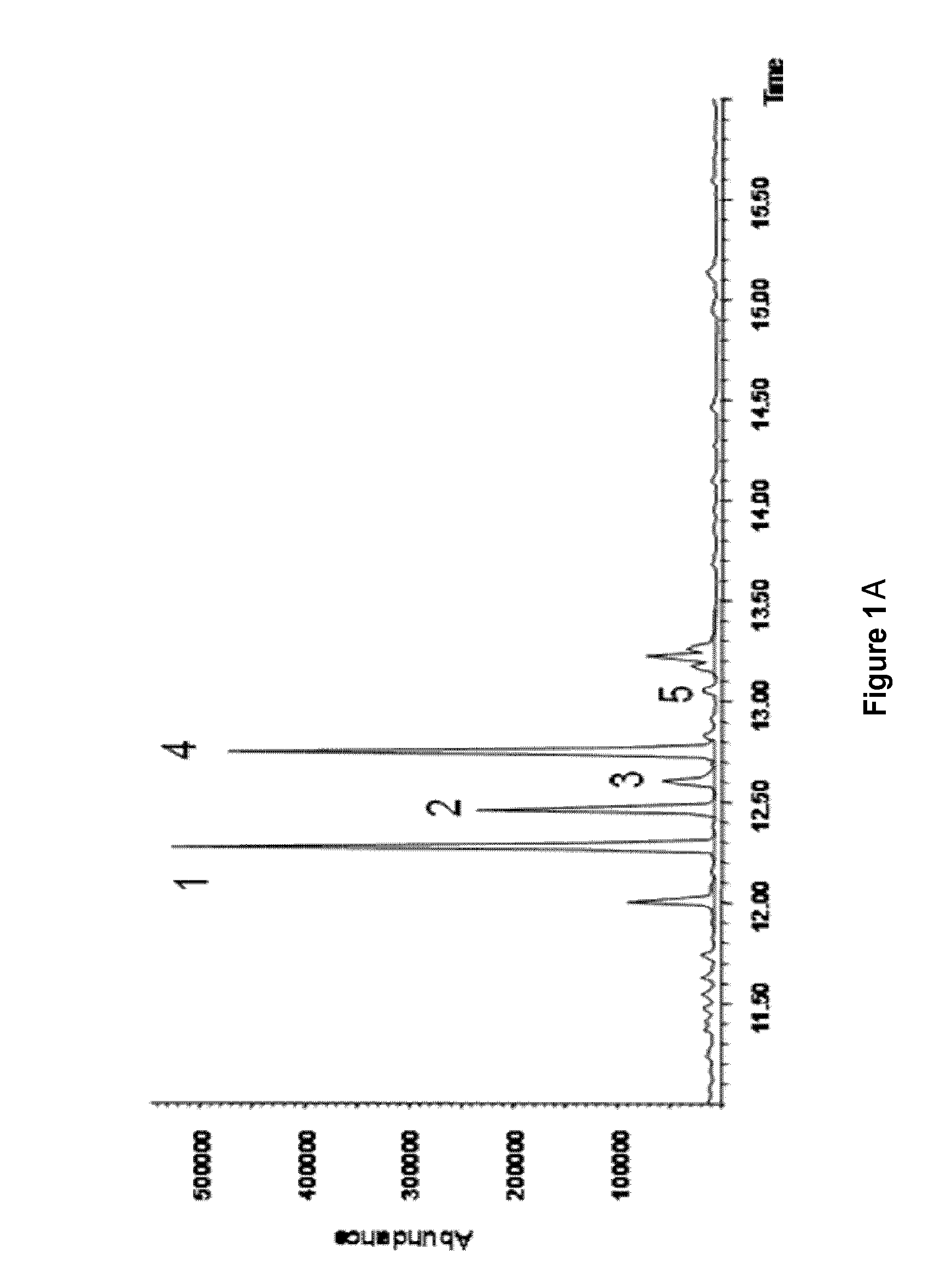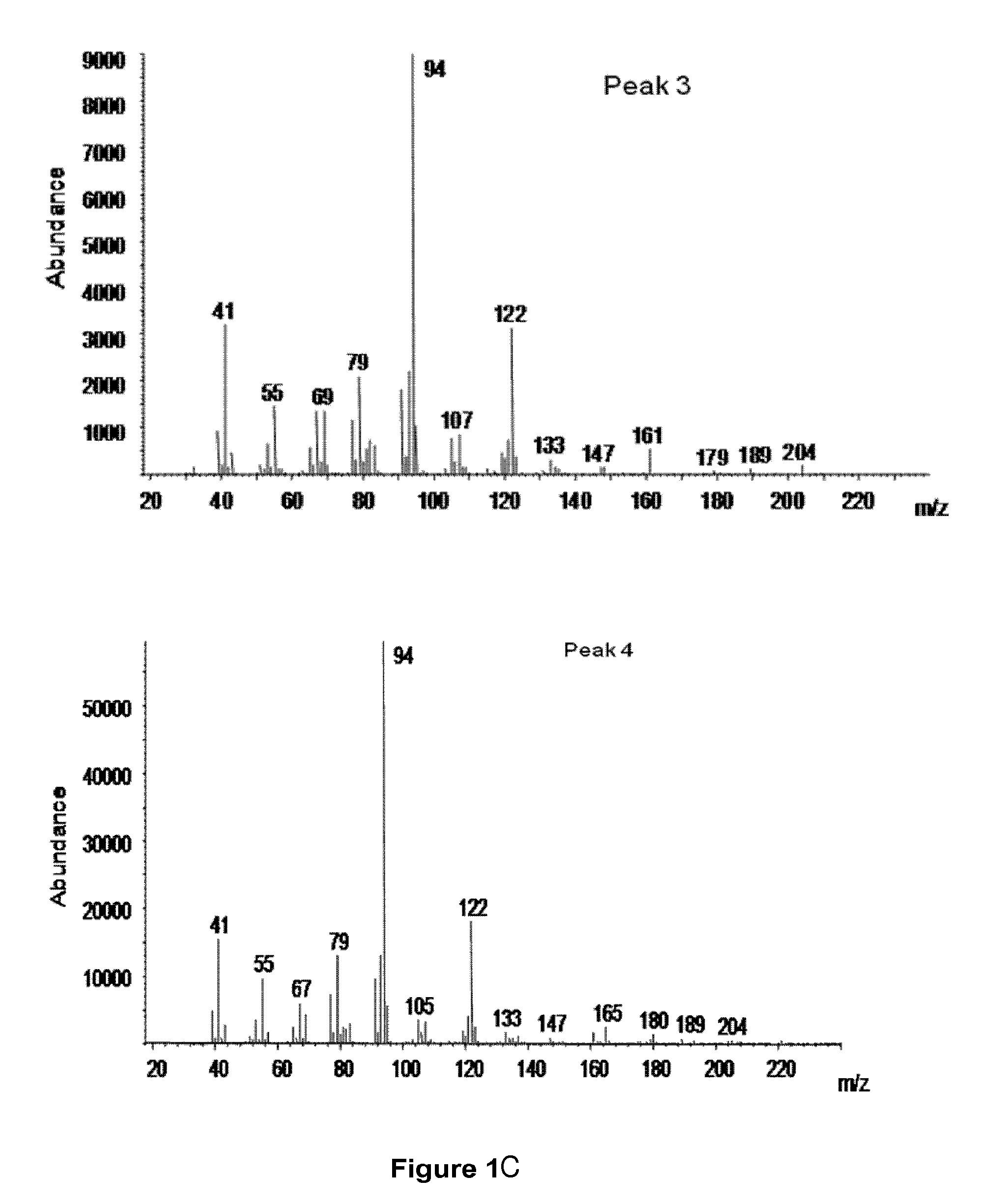Method for producing beta-santalene
a technology of sesquiterpene and santalene, which is applied in the direction of lyase, carbon-oxygen lyase, enzymology, etc., can solve the problems of not being able to produce -santalene, and unable to meet the requirements of high-quality perfumery
- Summary
- Abstract
- Description
- Claims
- Application Information
AI Technical Summary
Benefits of technology
Problems solved by technology
Method used
Image
Examples
example 1
DNA Library Construction, Sequencing and Extraction of Terpene Synthase Related Sequences
[0152]Young hypocotyls segments obtained from aseptically germinated seeds of Santalum album L. (5 weeks old) were used to induce callus formation. The seeds of S. album were obtained from B&T World Seeds (Aigues-Vives, France) and from Sandeman Seeds (Lalongue, France). The seeds were first surface sterilised in 2.5% HC10 for 120 minutes, and rinsed three times in sterile ultrapure water. The seeds were then shelled and placed on MS basal medium (Murashige & Skoog, 1962, Physiologia Plantarum 15, 473-497) supplemented with 15 g / L sucrose and 7.8 g / L agar, pH 5.7. Germination was typically observed after 9 to 18 days with a yield of approximately 40%. The plantlets were allowed to grow in-vitro for 2 to 3 months in a cultivation room at a temperature of 27° C., with cool, white fluorescent light and with a 16 hours photoperiod. To induce the formation of green callus, the hypocotyls segments wer...
example 2
Amplification of the Full-Length Sequences of a Terpene Synthase cDNA
[0156]For the RACE experiments, a set of primers was designed from one out of the five contigs obtained as described above. Thus the forward primers SCH5-Ct58-R1 (SEQ ID NO:6) and SCH5-Ct58-R2 (SEQ ID NO:7) and the reverse primers SCH5-Ct58-F3 (SEQ ID NO:8) and SCH5-Ct58-F4 (SEQ ID NO:9) were deduced from SCH5-contig-5 (SEQ ID NO:5).
[0157]The PCR were performed with the Universal Primer A Mix (UPM) (SMART™ RACE cDNA Amplification Kit, Clontech Laboratories, Inc.) in 50 μl final volume containing 200 μM dNTPs mix, 5 μl cDNA library (Example 1), 0.2 μM gene-specific primer, 0.2 μM UPM Primer Mix (Clontech Laboratories, Inc.), 1 μl Advantage 2 Polymerase Mix (Clontech Laboratories, Inc.) and 5 μl 10× cDNA PCR Reaction Buffer (Clontech Laboratories, Inc.). The thermal cycling conditions were as follows: 3 minutes at 94° C.; 5 cycles of 30 sec at 94° C. and 3 minutes at 72° C.; 5 cycles of 30 sec at 94° C. and 3 minutes...
example 3
Heterologous Expression and In-Vitro Enzymatic Activity of SCH5-Ct58
[0158]We decided to modify the DNA sequence of SCH5-Ct58 (SEQ ID NO:12) and to redesign the sequence for optimal heterologous expression in E coli cells. To start with the true amino acid sequence, the exact nucleotidic sequence of SCH5-Ct58 in the cDNA library had first to be established. The Eland Software (Illumina) was used to retrieve all reads matching with the SCH5-Ct58 sequence (SEQ ID NO:12) with a maximum of 2 mismatches. A total of 5224 reads were recovered and were aligned using the CAP program (Huang, Genomics 14(1), 18-25, 1992) with the SCH5-Ct58 DNA sequence (SEQ ID NO:12) as a reference. The average coverage over the whole sequence was above 100× allowing for the unambiguous deduction of the new cDNA sequence SCH5-Ct94 (SEQ ID NO:14). In this new sequence 5 bases were corrected compared to the SCH5-Ct58 sequence (SEQ ID NO:12) deduced from the RACE results and those corrections resulted in a new ami...
PUM
| Property | Measurement | Unit |
|---|---|---|
| optimal temperature | aaaaa | aaaaa |
| optimal temperature | aaaaa | aaaaa |
| optimal temperature | aaaaa | aaaaa |
Abstract
Description
Claims
Application Information
 Login to View More
Login to View More - R&D
- Intellectual Property
- Life Sciences
- Materials
- Tech Scout
- Unparalleled Data Quality
- Higher Quality Content
- 60% Fewer Hallucinations
Browse by: Latest US Patents, China's latest patents, Technical Efficacy Thesaurus, Application Domain, Technology Topic, Popular Technical Reports.
© 2025 PatSnap. All rights reserved.Legal|Privacy policy|Modern Slavery Act Transparency Statement|Sitemap|About US| Contact US: help@patsnap.com



